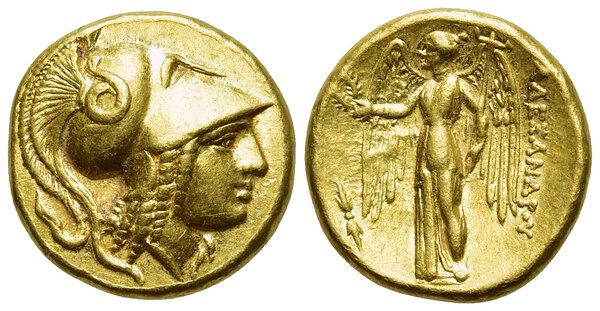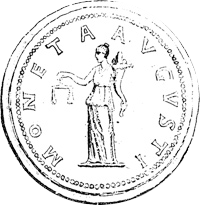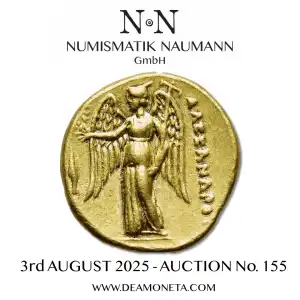



KINGS OF MACEDON. Alexander III 'the Great' (336-323 BC). GOLD Stater. Amphipolis. Possibly lifetime issue.
Obv: Head of Athena right, wearing Corinthian helmet decorated with coiled serpent.
Rev: AΛΕΞΑΝΔΡΟΥ.
Nike standing left, holding wreath and stylis. Control: thunderbolt in left field.
Price 164.
Already with Philip II the occupation of the Mount Pangaion region with its rich gold mines had made possible the abundant emission of gold coins, something that until then had been throughout Greece rather rare and linked to extraordinary circumstances or moments of crisis. Alexander, who imposed a single coinage throughout his vast empire, was able to issue States and their fractions in gold, using the Attic weight as the unit of measure. On the Staters the head of the goddess Athena with Corinthian helmet was depicted on the obverse, while a winged Nike was reproduced on the reverse. On silver tetradrachms, on the other hand, the head of Herakles with lion skin was depicted on the obverse and Zeus seated on a throne on the reverse (Phidian model). Toward the end of his reign there is an assimilation of the ruler with Herakles. The practice, derived from the Eastern world of reproducing the portrait of the ruler on the coin, represents a change with Alexander's coinage. But as if the human figure did not dare to suddenly replace that of the gods, the image is clothed with religious content, through its deification or identification with the deity. Even after his death for a long time Tetradrachms with the effigy of Alexander continued to be issued by his successors. The Macedonian king had the possibility to exploit for his coinage a large amount of precious metal from the vast empire he had conquered. The extremely rich mines scattered throughout this territory also made his successors self-sufficient.. The coin from that time became a symbol of the ruler's power and absolute authority; no longer protected by the image of deities, it became an instrument of propaganda and power.
Condition: Near mint state.
Weight: 8.60 g.
Diameter: 18 mm.
Obv: Head of Athena right, wearing Corinthian helmet decorated with coiled serpent.
Rev: AΛΕΞΑΝΔΡΟΥ.
Nike standing left, holding wreath and stylis. Control: thunderbolt in left field.
Price 164.
Already with Philip II the occupation of the Mount Pangaion region with its rich gold mines had made possible the abundant emission of gold coins, something that until then had been throughout Greece rather rare and linked to extraordinary circumstances or moments of crisis. Alexander, who imposed a single coinage throughout his vast empire, was able to issue States and their fractions in gold, using the Attic weight as the unit of measure. On the Staters the head of the goddess Athena with Corinthian helmet was depicted on the obverse, while a winged Nike was reproduced on the reverse. On silver tetradrachms, on the other hand, the head of Herakles with lion skin was depicted on the obverse and Zeus seated on a throne on the reverse (Phidian model). Toward the end of his reign there is an assimilation of the ruler with Herakles. The practice, derived from the Eastern world of reproducing the portrait of the ruler on the coin, represents a change with Alexander's coinage. But as if the human figure did not dare to suddenly replace that of the gods, the image is clothed with religious content, through its deification or identification with the deity. Even after his death for a long time Tetradrachms with the effigy of Alexander continued to be issued by his successors. The Macedonian king had the possibility to exploit for his coinage a large amount of precious metal from the vast empire he had conquered. The extremely rich mines scattered throughout this territory also made his successors self-sufficient.. The coin from that time became a symbol of the ruler's power and absolute authority; no longer protected by the image of deities, it became an instrument of propaganda and power.
Condition: Near mint state.
Weight: 8.60 g.
Diameter: 18 mm.


